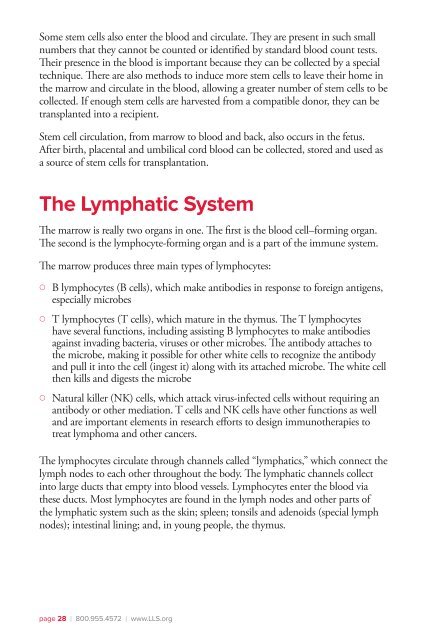Chronic Lymphocytic Leukemia - The Leukemia & Lymphoma Society
Chronic Lymphocytic Leukemia - The Leukemia & Lymphoma Society
Chronic Lymphocytic Leukemia - The Leukemia & Lymphoma Society
You also want an ePaper? Increase the reach of your titles
YUMPU automatically turns print PDFs into web optimized ePapers that Google loves.
Some stem cells also enter the blood and circulate. <strong>The</strong>y are present in such small<br />
numbers that they cannot be counted or identified by standard blood count tests.<br />
<strong>The</strong>ir presence in the blood is important because they can be collected by a special<br />
technique. <strong>The</strong>re are also methods to induce more stem cells to leave their home in<br />
the marrow and circulate in the blood, allowing a greater number of stem cells to be<br />
collected. If enough stem cells are harvested from a compatible donor, they can be<br />
transplanted into a recipient.<br />
Stem cell circulation, from marrow to blood and back, also occurs in the fetus.<br />
After birth, placental and umbilical cord blood can be collected, stored and used as<br />
a source of stem cells for transplantation.<br />
<strong>The</strong> Lymphatic System<br />
<strong>The</strong> marrow is really two organs in one. <strong>The</strong> first is the blood cell–forming organ.<br />
<strong>The</strong> second is the lymphocyte-forming organ and is a part of the immune system.<br />
<strong>The</strong> marrow produces three main types of lymphocytes:<br />
{ { B lymphocytes (B cells), which make antibodies in response to foreign antigens,<br />
especially microbes<br />
{ { T lymphocytes (T cells), which mature in the thymus. <strong>The</strong> T lymphocytes<br />
have several functions, including assisting B lymphocytes to make antibodies<br />
against invading bacteria, viruses or other microbes. <strong>The</strong> antibody attaches to<br />
the microbe, making it possible for other white cells to recognize the antibody<br />
and pull it into the cell (ingest it) along with its attached microbe. <strong>The</strong> white cell<br />
then kills and digests the microbe<br />
{ { Natural killer (NK) cells, which attack virus-infected cells without requiring an<br />
antibody or other mediation. T cells and NK cells have other functions as well<br />
and are important elements in research efforts to design immunotherapies to<br />
treat lymphoma and other cancers.<br />
<strong>The</strong> lymphocytes circulate through channels called “lymphatics,” which connect the<br />
lymph nodes to each other throughout the body. <strong>The</strong> lymphatic channels collect<br />
into large ducts that empty into blood vessels. Lymphocytes enter the blood via<br />
these ducts. Most lymphocytes are found in the lymph nodes and other parts of<br />
the lymphatic system such as the skin; spleen; tonsils and adenoids (special lymph<br />
nodes); intestinal lining; and, in young people, the thymus.<br />
page 28 I 800.955.4572 I www.LLS.org

















